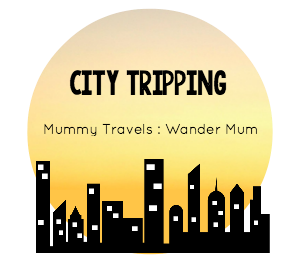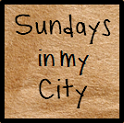I love Christmas decorations and seeing the twinkling lights. The sight of a Christmas tree standing in a main square makes me very happy. But I live in an area that does not really acknowledge Christmas. A problem? Not when Haifa is only a relatively short drive away. It is the third largest city in Israel after Jerusalem and Tel Aviv, and is a place where Israeli Arabs, both Muslims and Christians, constitute anywhere between 11% and 18% of the population (depending on whose statistics you accept). The city embraces its religious and cultural diversity and so I knew we would find some Christmas lights there. The kids were away on a youth club seminar and I asked Mister Handmade in Israel to take a day off work. We were going up to Haifa to see the lights!
I booked a room in the Port Inn, a hostel with very good reviews, overlooking the Port of Haifa. It was only a short walk away from the city's German Colony, where all the Christmas lights could be seen. The hostel was also very near to Wadi Nisnas (nisnas means "mongoose"), an Arab neighbourhood which holds the "Holiday of Holidays" festival in December around Christmas and Chanukah time. Though we were in Haifa midweek and the festival runs only on weekends, we were still able to see all the decorations in the houses and shop windows, without the accompanying crowds!
We arrived in Haifa late in the afternoon and headed to the port area, to Café Palmer, a trendy café on one of the most historical corners of the city. Café Palmer bears the name of the Port gate through which thousands of new immigrants made their way into Israel after World War II. Their coffee and croissants were delicious! Later on we walked to the German Colony, a small area located at the foot of the
Baha'i Gardens. It was founded in the late 1860s by German Templers and throughout the two world wars was inhabited on-and-off by the German Protestants who built the area up.
The name of the movement itself – The Templers – already tells us something about them. The Templers viewed each individual as a small temple. This is why they didn’t have churches, but a community hall instead. They believed that the Second Coming of Jesus would occur only if they lived in the Holy Land according to the morals of Jesus and the biblical prophets. Because of their extreme ideas, they were excommunicated from the Protestant Church in 1858. Ten years later, in 1868, they fulfilled their dream and established their first colony in Haifa. Using modern techniques and machinery, they tried to farm the land. However, they were harassed and plundered from by the local Arab community and eventually abandoned agriculture. The Templers began working in tourism and handicrafts. They initiated regular carriage services between cities, offered clean hotels, and were the first to use engines in their workshops.
Over the years, they lost their messianic fervour and began seeing themselves less as an avant-garde force that would hasten the Second Coming of Jesus and more as Germans living outside of Germany. They returned to the fold of the Protestant Church and erected churches in some of their settlements. In the 1930s, some sympathised with the Nazi movement and enlisted in the German army. When World War II broke out, they suddenly found themselves as citizens of an enemy state living under British rule. Some were deported to Australia and some to Germany. Today there are two Templer communities, one in Melbourne and one in Stuttgart.
In Haifa the Templers are long gone, but their stone houses still stand. Today Ben Gurion Street, the heart of the German Colony, is packed with restaurants, and at the city’s main roundabout in the middle of Ben Gurion Street, stood a large
hanukkiah, a Muslim crescent, and a fabulous Christmas tree, celebrating all three monotheistic religions in front of the holiest site for the Baha’i faith. In fact the whole street was covered in sparkly lights and each of the restaurants had really gone to town with their Christmas decorations.
Following the recommendation of our hostel, we ate at
Fattoush, a Middle Eastern restaurant with character, charm and delicious food. We sat outside (in December!) in the beautiful courtyard filled with olive trees hung with coloured lights. It was rather lovely!
The following morning we set off to explore Wadi Nisnas. Whilst we did find a somewhat picturesque neighbourhood, with narrow streets, old stone houses and buildings which were built during different eras and in many different styles, the market, which I had read so much about, was pretty much deserted. It was too early for falafel (the Wadi has two famous falafel stands which some claim to be the best in the country) so we walked on to explore other areas. We passed the Beit Hagefen Jewish-Arab Culture Centre, a meeting place for Haifa's different national, ethnic and religious groups, below, and continued on to the lower section of the Bahai Gardens, before jumping into a taxi to join a guided tour higher up on
Mount Carmel.
I have blogged about the Baha'i Gardens before and you can read all about my previous visit
here. They are possibly the most distinct tourist attraction in all of Haifa, and very likely the most visited. Every year hundreds of thousands of tourists and locals alike travel to the Baha'i Gardens, the most holy site of the Baha'i faith, to enjoy the beautiful terraces. The Baha'i Gardens contain nine concentric circles each filled with flowers, small trees, sculptures, water fountains and pools. To the sides of the gardens are wooded areas designed to house wildlife and to cut down on urban noise. The 200,000 square metres of land were designed by Iranian architect
Fariborz Sahba and was funded by donations made only by Baha'i the world over. The guided tour is the best way to truly experience the gardens, also providing a magnificent backdrop of the Haifa Bay.



Our next stop was
Haifa City Museum, a small museum created within an old Templer Community House, originally built in 1869 and recently restored in 2000. The current exhibitions, "To Collect Haifa" and "Everyday Souvenirs" display the private collection of an elderly Haifa resident, including photographs, postcards, documents, posters and other objects documenting the cultural history of Haifa. I particularly enjoyed the old posters but Mister Handmade in Israel is not a great museum lover and it was soon time to move on.





I had a vague memory of the Ursula Malbin Sculpture Garden from visits to my Great Aunt Rene, who we holidayed with in Haifa many times when I was young. The Sculpture Garden (in Hebrew
Gan Hapsalim), is also known as the
Mitzpor HaShalom (Vista of Peace) due to its stunning view of the Haifa Bay from its location in the hills above. The garden displays the work of the sculptress
Ursula Malbin, who was born in Berlin in 1917. In 1939 she fled Germany and met the sculptor
Henri Paquet in Geneva, marrying him in 1941. Malbin began sculpting in Switzerland, and bought a home in the
Ein Hod Artist’s Village in 1966.
The 29 bronze sculptures in the garden are mostly figures of men, women, children and animals from all walks of life, enjoying simple everyday activities. They are touching and easy to appreciate, capturing small moments and lots of compassion, joy and reality.
Malbin's works adorn private and public gardens, schools and institutional buildings in Switzerland and North America.
I enjoyed a few moments reminiscing my previous childhood visits before we moved on to our final stop of the day, the
Stella Maris Carmelite Monastery. The monastery is believed to be one of the oldest monasteries in the world, stretching back to 1291 AD. Its history is long and complex. The
Carmelite Order was established in the late 12th century when Crusader-era pilgrims, inspired by the prophet
Elijah, opted for a hermitic life on the slopes of Mount Carmel. Today the Order lives on around the world and in the Stella Maris (Latin for "Star of the Sea") monastery, whose current building was constructed in 1836.
Inside the church, the beautifully painted ceiling and dome, below, portray Elijah and the chariot of fire in which he is said to have ascended to heaven,
King David with his harp, the
Saints of the Order, the prophets
Isaiah,
Ezekiel and David and the Holy Family with the four evangelists below.
On the path leading to the church entrance, a pyramid with a wrought-iron cross on top serves as a memorial for 200 sick and wounded French troops, hospitalised here, who were slaughtered by the
Ottomans after
Napoleon returned to Paris in 1799.
The monastery was a spectacular way to end our visit to Haifa. It had started off as a trip to see the twinkling Christmas lights and ended up as so much more!
* This post has been shared on
Travel Photo Thursday,
Seasons,
Sunday Snap,
The Good. The Random. The Fun.,
You're The Star Blog Hop,
Our World Tuesday,
Pictorial Tuesday,
Ruby Tuesday Too,
The Happy Now Blog Link- Up,
Tuesdays Treasures,
Tuesdays with a Twist,
Wordless Wednesday (on Tuesday) and
Wednesday around the World.















































































